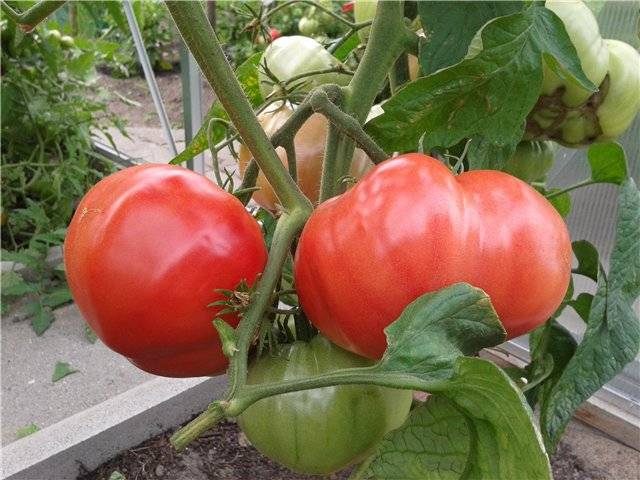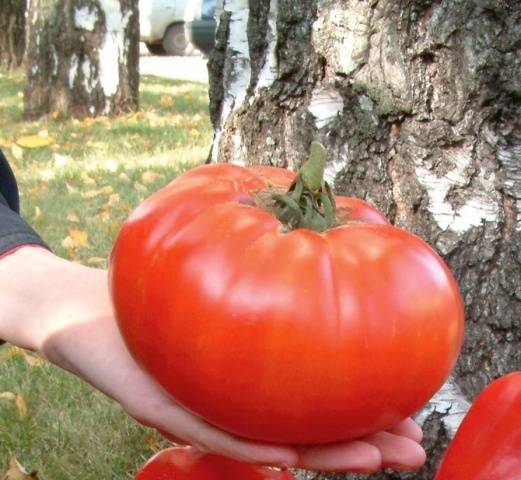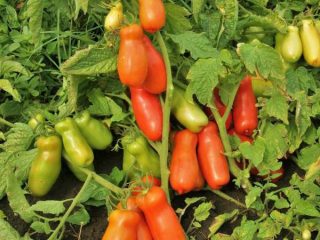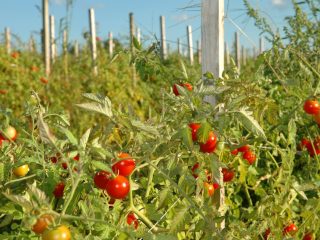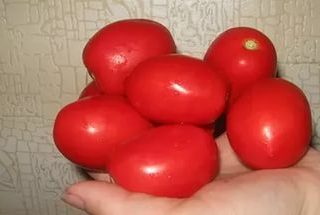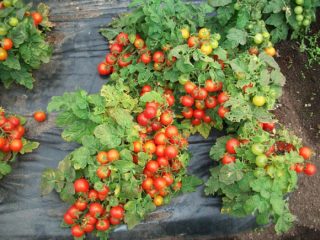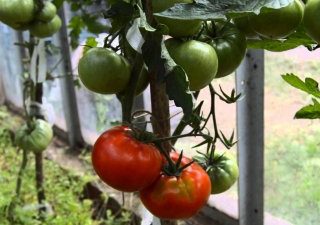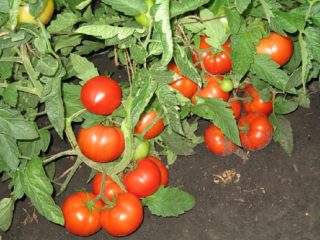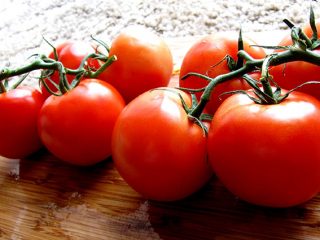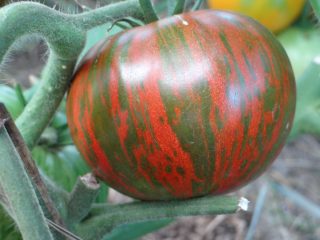Content
Tomato Russian size fully lives up to its name. This is a large variety, very productive, tasty, aromatic. It is used not only for home purposes, but also in large agrotechnical companies. This variety is cultivated on an industrial scale. The tomato bears fruit for a long time, and all the characteristics and descriptions of the Russian size tomato variety have made it popular for more than 20 years.
Description
The Russian size tomato is a late-ripening variety. The first harvest occurs 130-140 days after the first shoots. The variety is indeterminate, which means that there are no restrictions on its growth; it is recommended to pinch it. Additionally, the plant requires pinching, which creates 1-2 strong, strong stems.
The leaves do not differ in color and shape from other varieties. After 9 leaves appear in the axil, the first color begins to form, which appears every 3-4 leaves. As reviews show, the yield of the Russian size tomato is excellent, the photo confirms this:
The bushes bear fruit for a long time. Harvesting is best done in August, but it does not end there and lasts until frost.
The described giant tomatoes include many positive qualities that not all varieties can boast of. They can be used for fresh consumption or for preparing various dishes.
Visually, the fruits are round in shape, slightly flattened horizontally. The shape is slightly ribbed. Tomatoes will be pale green if not yet ripe, but when ripe the fruits will turn a deep red. The characteristics of the Russian size tomato can be described in a few words - very large fruits, the flesh is fleshy, and the weight of each tomato is from 600 grams to 2 kg.
As reviews show, the Russian size tomato is best consumed fresh, as slices and for salads. In some cases, tomatoes can be used for winter preparations, but they will need to be cut. The pulp is different from other varieties; it is very tender and juicy, with excellent taste. The tomatoes taste a little sweet.
According to lovers of this variety, if you use it in the form of slices for various preparations and dishes, the shape does not disappear. It is good to use the crop for making paste or producing juice. In addition, the variety is not bad in combination with other crops, which makes it possible to make assorted varieties.
Planting and growing
Since the Russian Size variety is a giant, you need to know some rules for growing it. Within a week after sowing, the first shoots appear, more often they appear together. After 1.5 weeks, 2 leaves appear on each plant that need to be picked.
After a month, the seedlings will need to be transplanted to a permanent place of growth. This variety is suitable exclusively for greenhouse cultivation. Due to their large size, seedlings are planted rarely so that the tomatoes can develop normally, are not pinched, and receive the required amount of nutrients from the soil.
After planting in the ground, after a few days you need to start tying up the bushes and do this as they grow. At the bottom of the bushes, the leaves break off; this can be done before the first inflorescence; pinching is carried out. The shoots that appear on the sides make it possible to achieve tillering. This is often used by gardeners to shape tomatoes. If the main task is to obtain small or medium-sized tomatoes, then you need to choose a couple of strong sprouts. To obtain large tomatoes, leave 1 stem at a time.
Depending on the height, the top may need to be pinched to limit growth. When growing, it is forbidden to frequently fertilize the soil, especially with organic types of fertilizer, which contain a lot of nitrogen. According to reviews, Russian size tomatoes love potassium or phosphate fertilizers. Fishmeal is used for this.
Care
Caring for tomatoes is very simple:
- The bushes must be watered constantly and abundantly. This makes it possible for the root system to develop better. If watering is insufficient or frequent, this leads to the formation of fruits on the sides, and they will not receive the required amount of nutrients during periods of low temperature or drought. For one bush, it is enough to use a liter of water.
- Between the rows and in the rows it is necessary to loosen the soil approximately every 10 days. If the soil is heavy, then it must be loosened 2 weeks after planting.
- Hilling up of the Russian size is carried out 10 days after planting the seedlings. Before the procedure, the ground is watered. It is necessary to hill up tomatoes a second time after 3 weeks.
- Feeding is carried out 2-3 times during the entire growing period.
During care, it is important to correctly form Russian-sized bushes.
Diseases and pests
According to reviews, the tomato Russian size F1 is a hybrid that is not afraid of standard diseases. Not terrible for the variety:
- Tobacco mosaic.
- Cladosporiosis.
- Fusarium.
If cultivation and care are carried out improperly, late blight may occur. During the growing season, it is recommended to carry out preventive measures using special substances.
Among the possible pests it is worth highlighting:
- Wireworm.
- Medvedka.
- Whitefly.
- Nematode.
Often, with a lack of nutrients in the soil, Russian hybrid tomatoes begin to undergo various changes and attacks from diseases or pests. The lack of useful elements can be determined by their characteristic features:
- Nitrogen deficiency can be determined by the color of the stem, leaves, and tomatoes. The leaves on the bushes become small, the color changes from green to yellow, and the veins below acquire a red-blue tint. The tomatoes themselves will not be as large, their hardness increases.
- Phosphorus deficiency is determined by the leaves curled inward.
- If there is little potassium, then the leaves curl.
- A lack of calcium provokes the appearance of yellow spots on young leaves, and on old leaves their size and color change. With a small amount of calcium, the upper part of the plant can rot, especially if there is high humidity.
- Sulfur deficiency is characterized by a pale tint of the leaves, and after a while they quickly and strongly turn yellow, and in some cases turn red.
- Boron starvation of tomatoes leads to the appearance of black spots in the area where the stem grows; the tomatoes themselves will have brown spots.
- A lack of molybdenum causes yellowness on the leaves, they curl upward, and after a while the plate is completely affected by chlorosis.
- Iron starvation causes tomato growth to stop. Young leaves undergo chlorosis.
If you properly care for it and provide timely feeding, then the Russian size will only please you. All inflorescences of the plant belong to the simple type. Up to 3 very large tomatoes can appear on one brush. People who use this variety for personal purposes know all the subtleties that make it possible to get giant fruits.
After the first tomato appears in the lower part of the hand, when the diameter of the fruit is about 5 cm, you will need to pick off the inflorescences and small ovaries, leaving only 2-3 of the largest fruits on the hand. If you leave only one tomato on the bunch, it can grow like a small melon.
Picking tomatoes
Assembly is not carried out immediately; initially, only deformed, damaged tomatoes need to be removed.
For long-term preservation of the Russian size variety, they should be picked not in a mature state, but when they turn brown. After this, you can send them for ripening. Tomatoes are removed until the temperature at night is less than +8 degrees. If harvesting is carried out later, storage will not work, and the fruits themselves begin to hurt.
The Russian size variety has extended fruiting, which means that the harvest is carried out from August until the first cold weather. With proper care, you can harvest up to 8 kg of tomatoes from 1 square meter. m.
Reviews
Conclusion
The Russian size variety is a valuable tomato that requires some attention from the gardener during cultivation. Due to proper care, there will be high yield, excellent taste and weight of each tomato.
